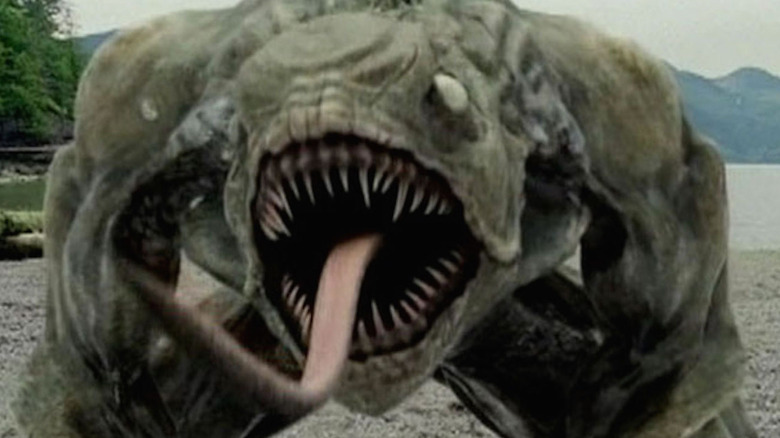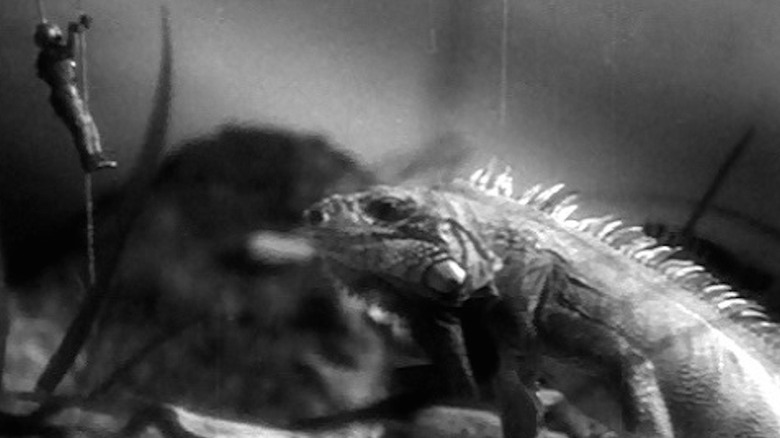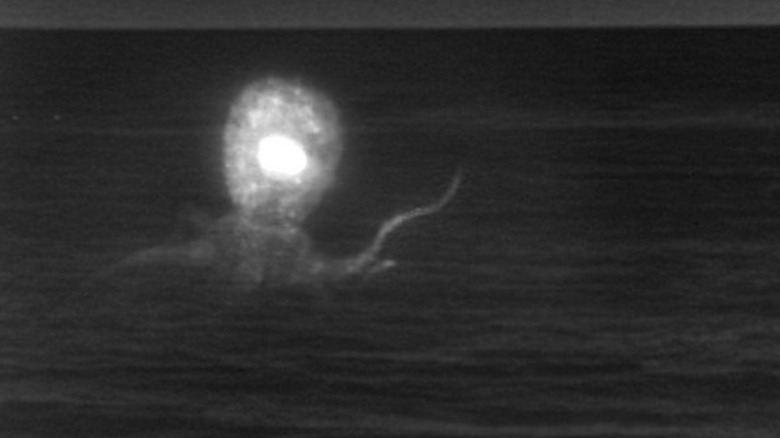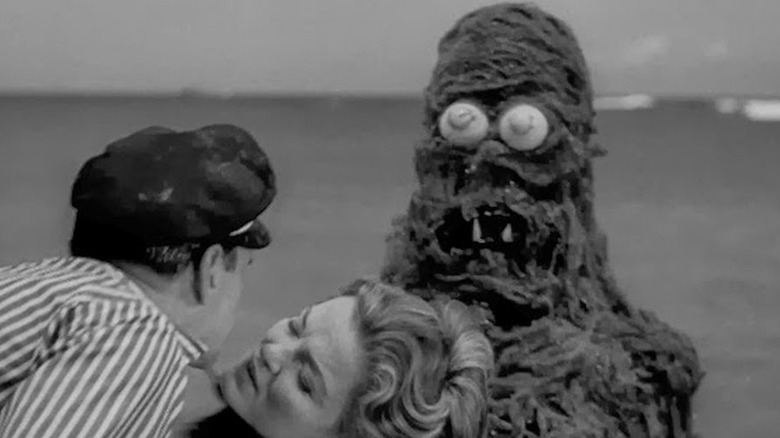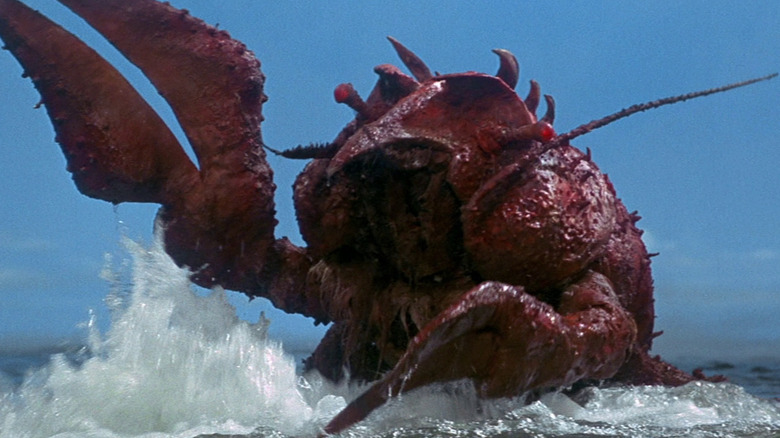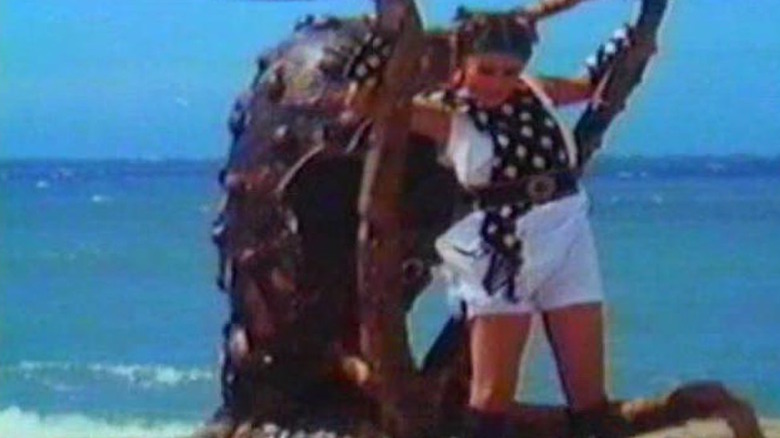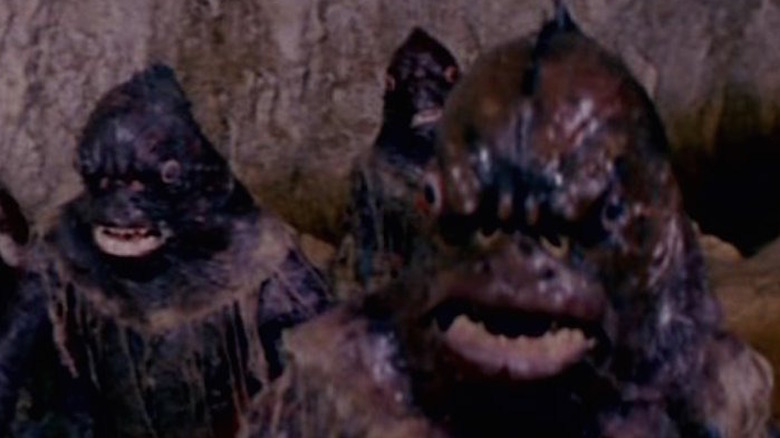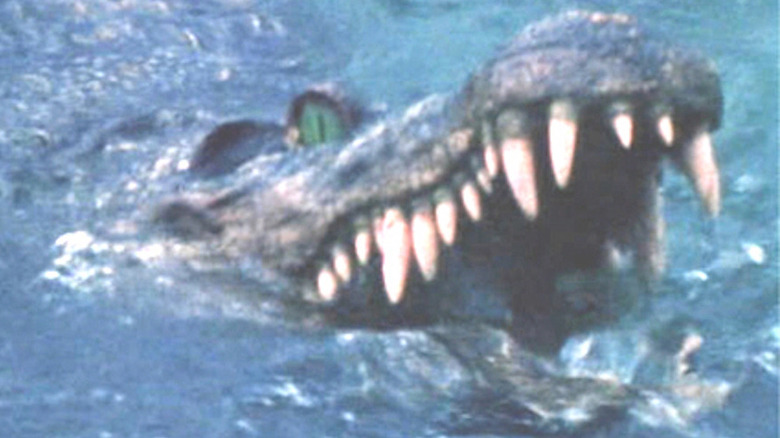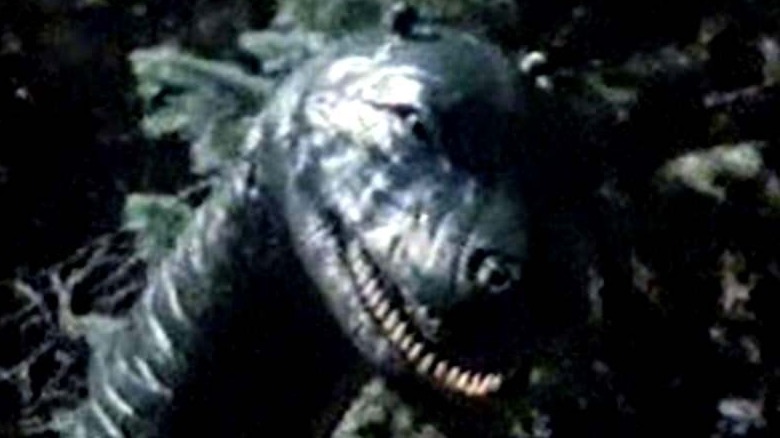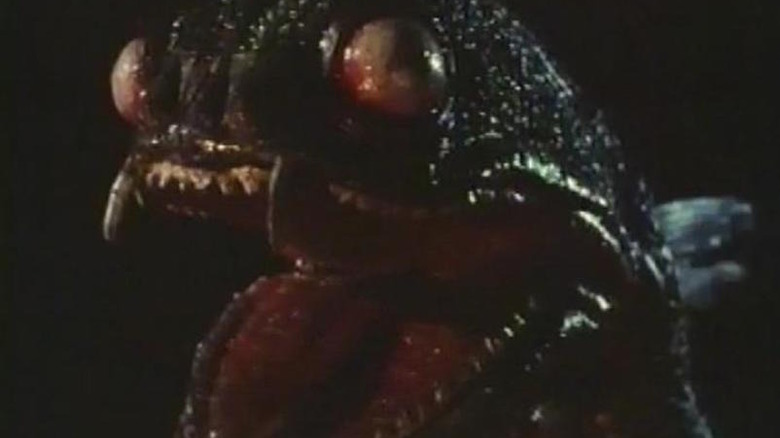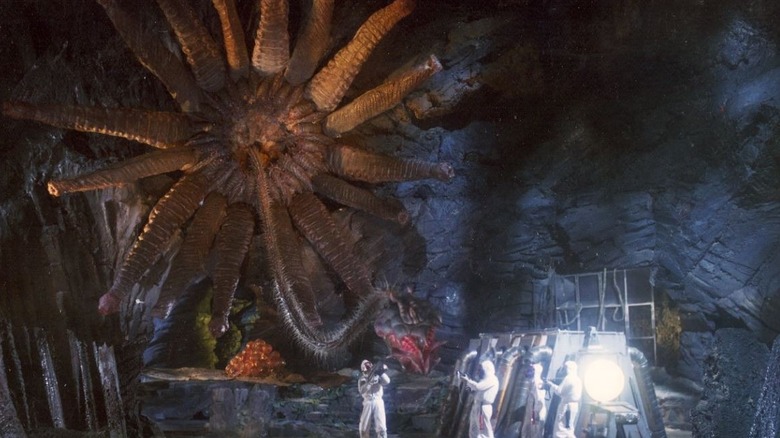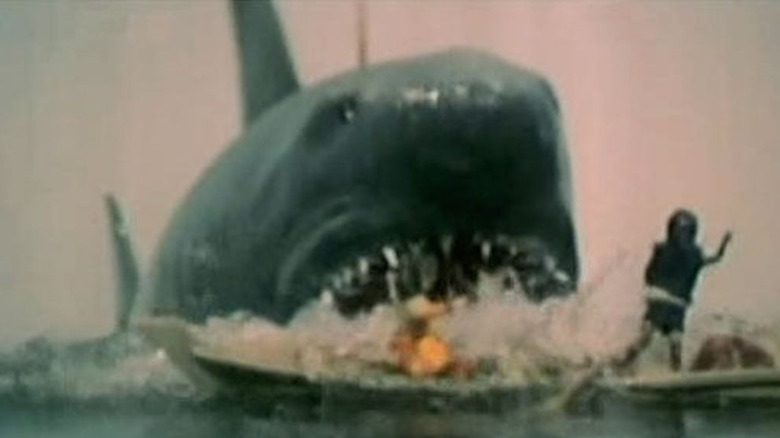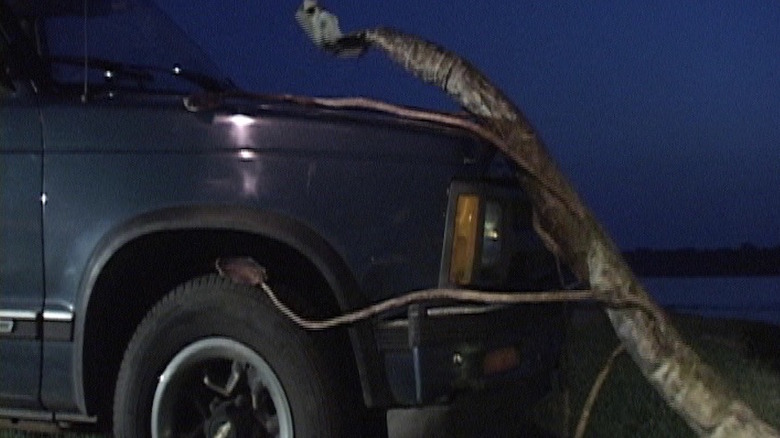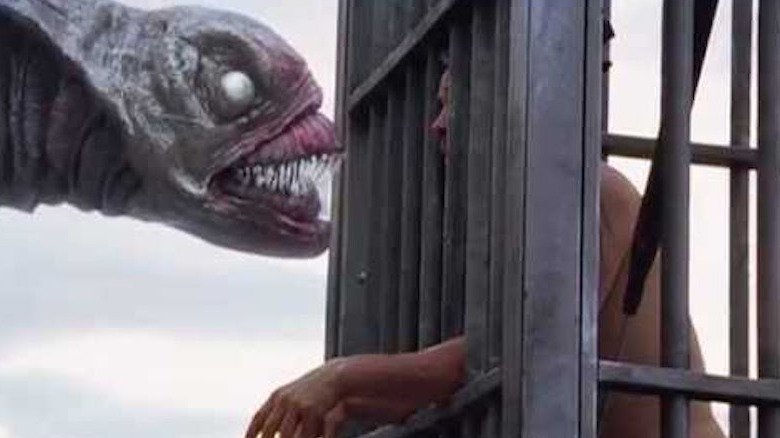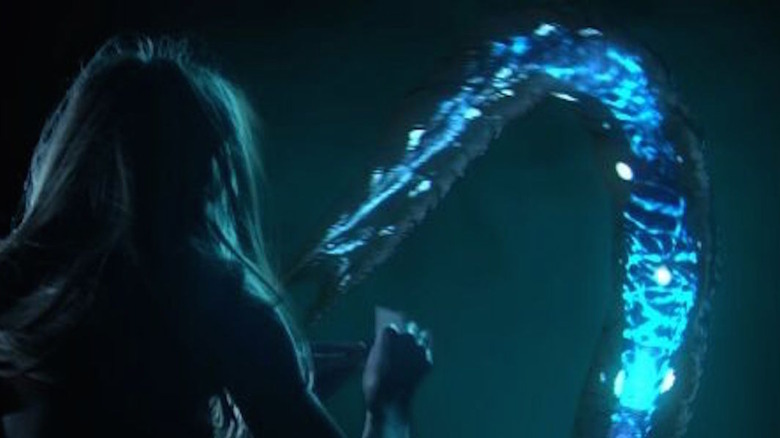The Most Ridiculous Aquatic Monster Movies That Actually Happened
More than 70 percent of our world is covered by water — oceans, seas, lakes and rivers, and even icecaps and glaciers. At its deepest point — the Mariana Trench — the ocean reaches a depth of more than six miles, which is enough to cover Mount Kilimanjaro if it were dropped to the bottom of the trench. Approximately 80 percent of the world's oceans remain unmapped and unknown, so it's no wonder that deep bodies of water leave us feeling a little unnerved.
Much of that fear is rooted in what might be living in that water, and what it might do to us if we ran afoul of it. In some cases, these fears are reasonable (such as in the case of sharks) while others, like sea monsters, are figments of our imaginations — at least, for now. Our aquatic terrors have manifested themselves in entertainment, including books, television, and movies. Some of the latter are bona fide classics, like "Jaws," while others are guilty pleasures, like "Piranha" or "The Meg."
Monsters of the deep aren't solely limited to studio films, however. Dozens of low-budget, half-baked, and just plain weird features have hinged their horror on watery creatures, which has produced some memorably bizarre and downright laughable movie beasts. With that in mind, here is a soggy, spoiler-y breakdown of the most bizarre and ridiculous aquatic monster movies that surprised audiences by simply getting made.
Secret of the Loch marked Nessie's movie debut
This 1934 British comedy coincided with a boom period in sightings of the Loch Ness Monster, capped by the famous (if fictitious) "Surgeon's Photograph," which was released to the public one month before "The Secret of the Loch." The film, directed by actor-turned-filmmaker Milton Rosner and co-written by frequent Alfred Hitchcock collaborator Charles Bennett (an Oscar nominee for "Foreign Correspondent"), is widely regarded as the first on-screen depiction of the lake monster, although its portrayal in the film is handled by an iguana, which nips sluggishly at romantic lead Frederick Peisley when he descends into the loch.
This encounter takes place 65 minutes into the 75-minute film, which is largely devoted to broad stereotypes of the Scottish population and the dotty ravings of a professor (played by British theater veteran Seymour Hicks) determined to prove the existence of the monster. "Secret of the Loch" is a minor entry in sea serpent cinema, and probably remembered best today as an early credit for David Lean ("Lawrence of Arabia"), who served as editor on the film. It shot at the legendary Ealing Studios, which produced some of the best-regarded British comedies of the 1940s and 1950s.
Monster from the Ocean Floor was an early Roger Corman credit
The 1954 creature feature "Monster from the Ocean Floor" is significant for several reasons, though none of them have to do with its titular sea monster. It's the first film produced by Roger Corman, who parlayed the writing fee from his debut film, "Highway Dragnet," into the paltry budget for "Ocean Floor." The film also marks the first appearance of actor Jonathan Haze, who plays a boat captain in the picture, and would go on to star in and/or write several Corman features, most notably the original "Little Shop of Horrors." The modest success of the film also helped to connect Corman with Samuel Z. Arkoff and James H. Nicholson, who served as producers for many of his features in the 1950s and 1960s.
The movie itself, which is directed by then-student filmmaker Wyatt Ordung (who also plays a Mexican fisherman), concerns an American tourist (Anne Kimball) in Mexico who discovers that a huge, one-eyed octopoid creature is responsible for a series of deaths in which the victims appear to have been dissolved. The creature's ominous ability is due to exposure to radioactive testing, but it stands little chance against Kimball — a pretty ballsy female hero for a 1950s feature, who shows a lot more mettle than the ostensible hero (singer Stuart Wade), who works overtime to mansplain or undermine her every move. The monster, created by puppeteer Bob Baker, is underwhelming, but its demise via one-man submarine is, at the very least, inventive. Corman himself turns up briefly as a member of the scientific team investigating the creature.
Corman went for comedy with Creature from the Haunted Sea
Some movie monsters are so poorly constructed or bizarrely conceived that the only logical answer for their existence seems to be as an elaborate private joke on the part of the filmmaker. That's true in the case of "Creature from the Haunted Sea," a 1961 horror-spy drama-thriller produced and directed by Roger Corman.
Shot back-to-back with two other films ("Last Woman on Earth" and "Battle of Blood Island") in Puerto Rico and built from leftover footage and funds from the former title, "Creature" is a comedy of sorts anchored around a gangster (Anthony Carbone) who plans to rob a Cuban general of money lifted from his country's treasury and blame it on the legendary title creature.
The wrench in the works is that the monster is real, and decimates the entire cast save for undercover spy Robert Towne — yes, the Oscar-winning "Chinatown" writer, hiding here behind the pseudonym "Edward Wain." How the creature accomplishes that goal is a bit of a mystery, since the beast — constructed by cast member Beach Dickerson from a wetsuit, tennis balls, an oilcloth and Brillo pads — appears unable to take a step without an intense struggle, much less devour a person. That may or may not have been due to the pair of divers' swim fins it sports when emerging from the Haunted Sea.
The King of the Monsters fights seafood in Godzilla vs the Sea Monster
Godzilla's seventh on-screen adventure sent him to a balmy South Seas island, where he encountered an eclectic array of foes, including Mothra, a giant condor, and Ebirah, a killer crustacean made colossal by nuclear waste from the weapons-making efforts of a terrorist organization. Their battles, filmed in 1966 as "Godzilla, Ebirah, Mothra: Big Duel in the South Seas," was released to Japanese theaters as "Ebirah, Horror of the Deep" before earning the less evocative title "Godzilla vs. the Sea Monster" for American TV audiences in 1968.
Special effects designer Eiji Tsuburaya creates an impressive suit for Ebirah, with different-sized claws and an ugly mouth, and director Ishiro Honda lends a degree of menace to its opening scene, where it capsizes a boat, and a follow-up where Ebirah skewers and devours two men attempting to flee the island. But all that advance notice has little impact on his two fights with Godzilla: though Ebirah briefly gains the upper hand by dragging the King of the Monsters underwater, Godzilla responds by first frying the sea creature with his atomic breath and then ripping off both claws. Godzilla even mocks the mutilated Ebirah by clacking the detached claw open and closed.
Ebirah returned twice to the Toho fold, first in the surreal "All Monsters Attack" (a.k.a. "Godzilla's Revenge"), which recycles footage from "Horror of the Deep," and later in "Godzilla: Final Wars," which teamed the creature with Hedorah, the living pile of radioactive sludge from "Godzilla vs. the Smog Monster." Once again, Ebirah plays the chump: blasted out of the waters of Tokyo Bay by Godzilla's atomic breath, the crustacean crashes into Hedorah and puts out its eye with a claw. The pair are spared further humiliation when Godzilla immolates them both with a single blast.
Kung fu meets giant octopi in Little Hero
There is precious little in your life that can prepare you for the onslaught of strange and silly images that comprise the 1978 Taiwanese action-fantasy film "Little Hero." The film serves as an excellent introduction to the strange film career of martial arts star Polly Shang-Kwan, who began with the legendary director King Hu but found her groove, as it were, in bizarro Taiwanese films like "Little Hero." As was the case in many of her films, Polly here plays a character regarded as a boy, despite all evidence to the contrary. That element underscores the film's deep departure from any sense of reality, which only deepens with each passing moment.
Volumes could be written about the film's inherent weirdness — its competing teams of outré heroes and bad guys, which include kung fu superstar Lo Lieh in a gold mask, dudes in tiger makeup, and a little person named Vampire — and the late, great historian and blogger Todd Stadtman does an excellent job of detailing its eccentricities here. For the purposes of this article, let us look at a sequence in which Polly, in pursuit of Lieh, finds herself on a beach occupied by two enormous if cumbersome octopi.
Said mollusks take it upon themselves to challenge Polly to a fight, which turns in her favor largely due to her ability to step gingerly over their tentacles. The octopoids mount a unique offense — they produce and shoot what appear to be baby octopi at her like missiles — before two of Polly's sidekicks show up to turn the tide. The trio pursues the creatures as they flee into the ocean and appear to beat them senseless, laughing wildly all the while. And from there, things get weird.
Atlantis, mad science, and Barbara Bach — it's all in Island of the Fishmen
Consider the 1979 Italian horror/science fiction hybrid "The Island of the Fishmen" a piscine take on "The Island of Dr. Moreau," complete with a benevolent but bonkers scientist experimenting on humans to "improve" on evolution. The doctor in question is American actor Joseph Cotten, whose "Citizen Kane"-to-"Fishmen" career has to rank among the all-time great career breadths. He plays a biologist who transforms unwilling subjects into stiff man-fish creatures, in the hopes of reducing overpopulation by allowing us to live underwater.
Claudio Cassinelli is the shipwreck survivor who washes ashore on Cotton's island, while Richard Johnson ("The Haunting") is the bad guy who wants to use the fishmen to raid the city of Atlantis, located conveniently offshore. Bond girl and Beatle spouse Barbara Bach is on hand for menacing purposes by both Johnson and the fishmen.
Directed by prolific Italian genre director Sergio Martino, "Fishmen" is an amusing period adventure with impressive scenes filmed inside Neptune's Grotto, a stalactite cave on the island of Sardinia. U.S. viewers got to see "Fishmen" trimmed of 30 minutes and released not once, but twice: first as "Something Waits in the Dark," with new footage shot at Bronson Caverns in Los Angeles and built around American actors Cameron Mitchell and Mel Ferrer. When that version failed to score at the box office, a second version, titled "Screamers," was released to theaters, this time promising footage that showed a man turned inside out while alive. The problem: said scene existed only in the trailer for "Screamers," and had to be edited into the film after audiences complained.
The Crocodile's favorite cuisine is Thai
The crocodile — both freshwater and saltwater variations — enjoys a degree of stardom as a movie monster that ranks slightly below sharks and sea serpents. Huge, hungry crocs have been top-billed in numerous movies ranging from the American "Lake Placid" franchise (currently numbering six films) and "Primeval" to Australia's "Rogue" and "Black Water," Italy's "Killer Crocodile," and Tobe Hooper's "Crocodile." Lurking at the bottom of this list is 1979's "Crocodile," an Asian horror film about a giant croc unleashed by a tsunami caused by an atomic explosion(!).
Said croc — whose dimensions shift throughout the film from roughly man-sized to airliner length — chews up literally everything in its path, from adults and children to various animals (including a real monkey and water buffalo) before the film's hero takes matters into his own hands after his wife and daughter are gobbled up. The croc is mostly portrayed by a large, stiff model head in which various victims kick and scream.
Sources vary as to the origin of "Crocodile"; various prints list Thai, Korean, American, and Chinese production companies, each of which issued different versions of the film. What is known is that the man behind the camera is notorious Thai director Sompote Sands, who ran afoul of Tsuburaya Productions for claiming that he had the right to create "Ultraman" films and TV shows. Sands' long c.v. features some truly off-the-wall projects, including "Magic Lizard," which features a man in a frilled lizard costume whose stream-of-consciousness adventures include an encounter with the oversized prop from "Crocodile."
The Loch Ness Horror features one angry Nessie
Texas-based filmmaker Larry Buchanan, whose list of credits includes numerous poverty-strapped horror and science fiction titles (see: "Mars Needs Women"), took a swing at water monsters with 1982's "The Loch Ness Horror." Buchanan's Nessie isn't the amiable, semi-bovine monster seen in family-friendly films like "The Water Horse: Legend of the Deep" and "Nessie & Me." His beast is instead a ceaselessly shrieking man-eater that chews up anyone who disturbs it or its nest of eggs.
While that may sound like a guaranteed good time for monster movie devotees, it's important to note a few things. Buchanan's Nessie is mostly portrayed by a stiff rod puppet that requires victims to shove their heads into its mouth in order to depict being eaten alive, while the terrain and people of Scotland are represented by Lake Tahoe, with American actors spewing forth atrocious Scottish accents.
"Horror" is also bogged down by numerous unnecessary subplots, including the discovery of a WWII German bomber in the loch (!) and a romance between American researcher Brad Buchanan (one of several Buchanan family members, collectively labeled in the credits as the "Buchanan clan," who worked on the film) and the granddaughter (Miki McKenzie) of the crank who first photographed the monster. These loose elements thread together in the film's conclusion (sort of), which leaves the door open for a sequel that absolutely no one wanted.
A stiff Sea Serpent spreads laughter by the Spanish seaside
Director Amando de Ossorio, who helmed some of the best Spanish horror movies of the 1970s, including the memorable "Blind Dead" quadrilogy, capped his career with 1985's woeful marine monster movie "The Sea Serpent." American actor Timothy Bottoms, a popular star in the '70s who later played George W. Bush on several occasions, stars as a fisherman who teams with a cranky biologist (fellow ex-pat Ray Milland, in his last screen role) to battle the titular creature, a snaky sea monster brought to life when an American bomber accidentally drops its nuclear payload into the waters off the Spanish coast.
The sea serpent turns out to be a stiff, puppet-like creature outfitted with googly eyes and an incessant, high-pitched howl. Two versions appear in the film: a smaller serpent that wreaks havoc on numerous miniature sets, and a larger, even more immobile incarnation with a rigid maw just wide enough for actors to enter and thrash about in while pretending to be devoured alive a la "The Loch Ness Horror" and "Crocodile." After consuming most of the supporting cast, the beast is dispatched with explosives and is described as heading for Africa — a fact regarded with "not in my backyard" dismissal by the surviving characters.
More Spanish sea creatures star in The Rift
Produced at the tail end of the late '80s-era mini-boom of underwater monster movies spawned by "The Abyss" (see "Leviathan," "Deep Star Six"), the U.S./Spanish feature "The Rift" (a.k.a. "Endless Descent") can't compete with studio-funded special effects for its story of a submarine crew encountering aquatic mutations in a deep-sea ravine. It instead settles for an abundance of slime-covered monsters, rendered through practical effects (suitmation, miniatures, and puppetry), and gallons of gore spilled by the Spanish and Stateside cast, which includes R. Lee Ermey and Ray Wise.
Taken at face value — meaning that "The Rift" is mostly an amalgam of tropes swiped from "Alien" — the film isn't a total mess. Ermey and Wise are always fun to watch (the less said about leaden ostensible lead Jack Scalia, the better), and director Juan Piquer Simon — whose horror credits includes the supremely icky "Slugs" and "Pieces" — makes the most of his modest budget by laying on the explosions and splattery deaths with a trowel. The monster designs, too, have the right mix of ludicrous and inventive, with the giant, carnivorous starfish that faces off against the crew in the finale the sort-of highlight. It's no Starro the Conqueror, but it does put up a decent fight.
A giant shark attacks between Bollywood numbers in Aatank
Pity young Jesu (played by beefy Bollywood star Dharmendra) in "Aatank." His problems are many: he's lost his mother, his tiny fishing village is under the control of gangster Alphonso (Amjad Khan), and the promise of money in the discovery of valuable pearls is upended by the appearance of a colossal shark.
Said creature — which issues something like a human scream and appears to measure somewhere between "The Meg" and the state of Rhode Island — further complicates matters by devouring both his adopted brother Peter (Vinod Mehra) and the brother's wife, a pair of kids on a raft, various minor characters, and in the film's most bonkers sequence, a helicopter in mid-flight.
This 1996 Indian adventure thriller reportedly began production in the mid-1980s, but wasn't completed until nearly a decade later; fans of monster sharks should know that the creature doesn't actually appear until an hour into the movie, which up until that point, plays like a gangster film crossed with a coming-of-age drama. Once the shark does make its appearance, it's non-stop mayhem: even the pre-requisite Bollywood musical numbers can't rein in its rubbery rage, as evidenced by the sequence in which actress Nafisa Ali croons a tune while taking a dip in the ocean before the beast gobbles her up, mid-note.
Watch out — It's the WAWA
The "WAWA" referred to in the title of the 2007 American indie "Birth of a Legend: The Story of the WAWA" is not the convenience store so beloved to residents in the Mid-Atlantic states, but rather a swamp monster that plagues the sleepy (and fictitious) town of Sweet Tee, Alabama. The creature — the product of a misguided scientific experiment which merged catfish DNA and "radiated plastic fishing worms" — makes a habit of dining on the town's residents, which earns it the moniker WAWA, or West Alabama Whoop A**.
The WAWA's origin story gives a good indication of the film's tone, which offers a comic take on '50s-era monster movies and Southern stereotypes in proudly broad and un-PC terms with a cast of local theater and non-professional actors. In an interview, producer Sheri Wiggins said that she and her husband, director Steve Wiggins, originally envisioned the WAWA as a mutant catfish — a subject covered in the bewildering 1971 Florida-lensed creature feature "Zaat"— but opted instead for an enormous, irradiated worm.
The Sea Beast has a sneaky super power
The 2008 feature "Sea Beast" offers what might be considered a novel wrinkle on the monster-from-the-ocean-depths premise: its B-minus-grade CGI fishmen, which prey upon the residents of a small coastal town, are equipped with a variety of special abilities, including a long tongue they uses as a weapon, a toxic slime that causes grievous wounds on contact, and the ability to disappear (more or less) a la "Predator." They are also remarkably fecund, producing small armies of little sea beasts with the same appetites as their parents.
Standing in opposition to this aquatic menace is a uniformly doltish crew of locals, including a faux Quint (Brent Stait), a dim sheriff (Gary Hudson), and a scientist (Camille Sullivan) whose revelation that the creatures are related (sort of) to angler fish helps in no way to reduce the film's body count. It's up to SyFy vet (and onetime Parker Lewis) Corin Nemec to construct a hopelessly complicated trap for the monsters. Spoiler alert: it works.
You'll get more than a burned foot from stepping on The Sand
In 2015's "The Sand," a gaggle of college kids recover from a night of partying on the beach to find themselves in a unique situation: the evening's revelry has separated them into small groups deposited at various locations — a lifeguard station, a car, and worst of all, a trash barrel — that they dare not leave. It seems something in the sand has consumed their fellow partygoers, and anyone foolish enough to set foot on the ground faces a very messy death.
Directed by veteran set dresser Isaac Gabaeff and written by frequent WWE scribe Alex Greenfield and Ben Powell (who penned two episodes of the "V/H/S" series on Snapchat), "The Sand" hinges on a fairly silly premise — like the 1980 film "Blood Beach," which featured a monster under the beach, the villain here is an unremarkable burrowing jellyfish creature, depicted as a sort of low-wattage mass of bioluminescent CGI tentacles. The computer effects also undo the gruesome intentions of several death scenes.
Having said that, "The Sand" is also fairly well-acted by its largely unknown cast (save for ex-"Hannah Montana" star Mitchel Musso), and Gabaeff delivers several suspenseful moments that hinge on the survivors' attempts to escape their unpleasant fate. Some work, and some don't, which lends a satisfying element of unpredictability to the proceedings. Heck, any movie that trots out Jamie Kennedy as a dull-witted park ranger whose sole purpose is to meet an ugly death can't be all bad.
